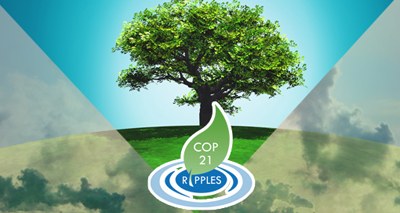Energy: ENEA analysis of national post-COP21 decarbonisation policies
26/3/2020
 Development of deep decarbonisation scenarios by 2050 and analysis of Italy's industrial competitiveness for the production and export of some of the main low-carbon energy technologies, such as photovoltaic panels, batteries and electric vehicles. These are the ENEA contributions to the European project COP21 RIPPLES [1], funded by the EU Horizon2020 program with approximately 3 million euro and coordinated by the French Institut pour le Developpement Durable, in collaboration with 17 international research institutes [2].
Development of deep decarbonisation scenarios by 2050 and analysis of Italy's industrial competitiveness for the production and export of some of the main low-carbon energy technologies, such as photovoltaic panels, batteries and electric vehicles. These are the ENEA contributions to the European project COP21 RIPPLES [1], funded by the EU Horizon2020 program with approximately 3 million euro and coordinated by the French Institut pour le Developpement Durable, in collaboration with 17 international research institutes [2].
Overall, the project examined national and global post-COP21 decarbonisation policies, reviewing aspects such as technology development, industrial innovation and financial flows needed to accelerate the decarbonisation process, in a prospect of sustainable development and social equity.
"Italy is quite good at exporting some low-carbon technologies such as solar thermal, hydroelectric and energy efficiency, while it has poor import specialization in photovoltaics, biofuels and nuclear power", Maria Rosa Virdis, researcher at the ENEA Division Models and Technologies for the Reduction of Anthropogenic Impacts and Natural Risks, explained.
"To further confirm the Italian picture there is the analysis that we conducted on patents, but our country could still play a role in new sectors such as electric mobility, thanks to recent electrification plans with hybrid, plug-in hybrid and full electric cars of a national sample of the automotive industry ”, Virdis said.
In this regard, an in-depth analysis dedicated to the development of the most important technologies for electric mobility (lithium-ion batteries) shows that Italy is a net importer, risking to remain so even in a scenario of rapid development of the sector.
"Despite some strong points, there is still a substantial lack of preparation by the Italian industrial system to cope with these market changes and to seize the opportunities of the electric car. But luckily, we are starting to register some changes both in terms of industrial policy and by large companies ", the ENEA researcher pointed out.
Overall, the analysis shows that for scenarios aimed at limiting the temperature rise below 2 ° C (for example 1.5 ° C) all EU countries should pursue more ambitious strategies and accelerate the steps compared to reference scenarios or those aimed at 2 ° C.
By 2050 fossil fuels should gradually be phased out, while renewable energy should meet more than half of the demand for electricity, as is expected for Italy, Spain and Germany. In Poland, the Czech Republic and the United Kingdom an increase in the use of nuclear fission energy is expected, which countries like France and Germany have decided to reduce or abandon by 2025, and which should be 'replaced' with massive investments in energy efficiency and renewables.
As for the decarbonisation of transport - i.e. an 85% reduction in CO2 emissions (compared to 2014 levels) by 2050 in a scenario below 2 ° C - the project COP21 RIPPLES underlines the need for a greater use of electrification and new generation batteries (such as lithium-ion), while hydrogen could still remain a niche market, covering about 1% of the EU's transport demand by 2050 (due to uncertainties on the cost of fuel cells).
In Italy over half of the total demand for energy for transport should be met by electricity; high shares of electricity consumption are also expected in France, Germany and the Czech Republic, but the latter Countries would also make a significant use of biofuels. "In general, at the European level, we are still not in line with the commitments made under the Paris agreements to mitigate climate change.
The current challenge is to better understand the nature of the gap between the commitments made and the national medium-long term objectives and to deepen the debate on implementation policies at all levels. The European Green Deal today represents an opportunity to develop an adequate and concrete response to the objectives set by COP21", Virdis concluded.
In order to comply with the Paris agreements, the project has defined a series of national and European guidelines to accelerate the decarbonisation process, such as anticipating investments in new technologies, promoting a greener financial system, strengthening the decarbonisation objectives by 2030 and, above all, to place industrial policy at the center of this challenge, starting from fundamental sectors such as the automotive and steel industry.
For more information please contact:
Maria Rosa Virdis, ENEA – Division Models and Technologies for the Reduction of Anthropogenic Impacts and Natural Risks, mariarosa.virdis@enea.it
[1] Results and Implications for Pathways and Policies for Low Emissions European Societies
[2] Bruegel, Climate Analytics, Climate Strategies, The Euro-Mediterranean Center on Climate Change (CMCC), The National Center for Scientific Research (CNRS), The COPPETEC Foundation, The Institute for European Studies (IES) at the Vrije Universiteit Brussel (VUB), Sofia University, The Chancellor, Masters and Scholars of the University of Cambridge, The Chancellor Masters and Scholars of the University of Oxford, Tsinghua University, University of Cape Town (UCT), University College London (UCL), University of East Anglia (UEA), WiseEuropa, Wuppertal Institute
